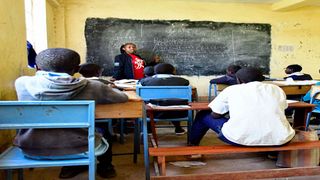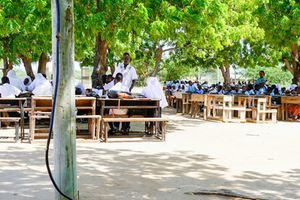
Korara Special School and Junior Secondary School Teacher Chepngetich Damaris takes her Grade 7 students through an Agriculture class on September 22, 2023.
| Francis Nderitu | Nation Media GroupEducation
Premium
How CBC system poses unique problems for special needs schools
Ms Damaris Chepngetich’s work at Korara Special School goes beyond the call of duty. She is teaching the 12 Grade Seven (junior school) learners as she awaits to graduate from Kenyatta University.
Ms Chepngetich was hired by the board of management to stand in for the regular teacher, who is on maternity leave.
“Teaching the competency-based curriculum (CBC) to learners with special needs is more demanding than teaching learners in regular schools,” she told Nation.
This became evident when the Nation sat through an agriculture lesson that she taught her class comprising learners with low vision and others who are totally blind. Her lesson takes considerably much longer than usual as she has to supervise what every learner is writing. However, she gets help from other teachers in the primary section.
Korara Special School is 26km away from Bomet town on the Bomet-Mulot highway. Its total enrolment is 152 and draws learners from 12 counties. It borders Korara Primary School, which also has some learners with disability but who follow the regular curriculum.
“It was a nightmare at the beginning because we’d not gotten any teaching and learning materials. After searching on the internet for some content, we were able to move on. We later secured some books for learners with low vision but not for the totally blind. Up to now, we don’t have copies for Braille and that has been a challenge in assisting learners who are totally blind,” said the headteacher, Mr Charles Sigei.
He explained that, to make up for lack of material, they have to convert the print matter into Braille using an embosser.
“When we don’t have the Braille books we use the embosser and embossing paper. A realm of embossing paper goes for Sh14,000. A scientific calculator for these learners goes for Sh80,000. Whatever we receive from the government isn’t enough to meet the cost,” Mr Sigei said.
The report of the Presidential Working Party on Education Reforms (PWPER) has recommended a review of the capitation allocated to learners as follows: Sh1,170 for learners in pre-primary, Sh2,238 for primary level, Sh15,043 for junior school and Sh22,527 for day senior school.
For learners with special needs, the report recommends an enhanced capitation of Sh19,800 for day junior school and Sh38,280 for boarding junior school and that the capitation and grants be reviewed every three years.
“SNE [Special Needs Education] is funded using a weighted single, flat model where students with disabilities attract the same amount of funding. This approach has been criticised for not considering the diversity of needs arising from different disabilities, hence a uniform allocation that is unfair and hinders access, quality and retention,” the report observed.
Teachers who spoke to Nation also complained about the amount of work SNE learners have to handle. They said this makes the syllabus coverage difficult and learners might not acquire the desired competencies.
“The content is too much. Some subjects like performing arts are not adapted to suit these learners. We do not have adequate assistive devices for SNE,” a headteacher of another school in Nairobi City County told the Nation.
SNE schools are required to have a nurse. They also need more ancillary staff to assist the learners depending on the nature of their disability. However, many schools are unable to hire them due to lack of funds.
Teachers in SNE schools who spoke to Nation accused the Kenya Union of Special Needs Education Teachers (Kusnet) of not agitating for their welfare.
“I’m a member of Kusnet but I don’t even know its leadership. They just take their deductions from our salaries but they never do anything to help the sub-sector,” said a teacher.





